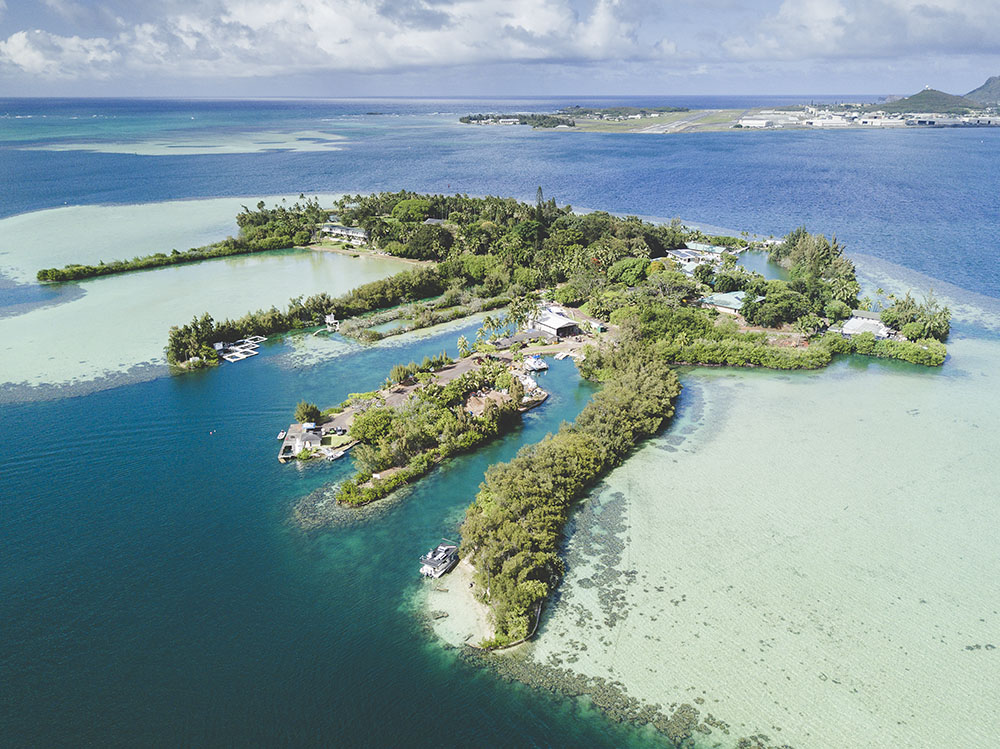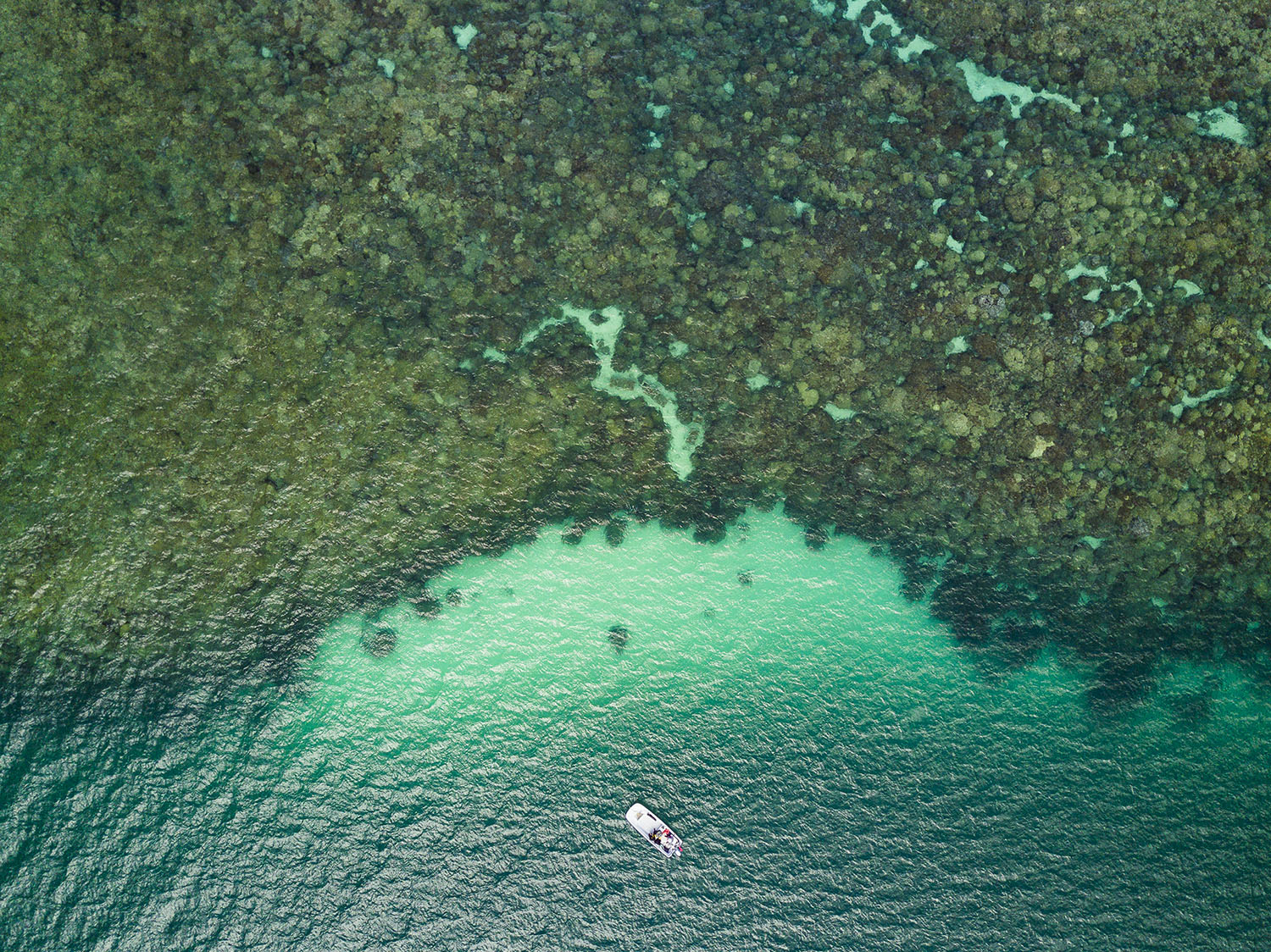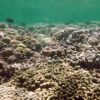Faced with a warming climate, coral researchers are working to reverse engineer the future through “assisted evolution.” What if nature isn’t what needs to evolve?
The Hawai‘i Institute of Marine Biology occupies several bland, bunker-like buildings near the center of Coconut Island, which sits a quarter mile offshore of Kāne‘ohe. It’s not the easiest place to reach. You don’t just drive up and park. Instead, to visit the institute, which is home to a series of research laboratories affiliated with the University of Hawai‘i at Mānoa, you must take at least two shuttle rides: the first in an aging, gray Honda CR-V, which ferries you from a parking area near Windward Mall to Lilipuna Pier; the second via a skiff with a makeshift shade canopy that collects you from the end of the pier and takes you the rest of the way.
Earlier this spring, I made the multi-leg journey to Coconut Island to visit the Gates Coral Lab. Founded in 2003 by Ruth Gates, a Cyprus-born marine biologist, the lab has produced some of the world’s most important coral research. Gates gained international recognition earlier this decade when she issued a clarion call for the world’s coral. Earth’s coral reefs were in serious trouble, Gates insisted in interviews with National Public Radio, National Geographic, and VICE News. The oceans were warming, and corals couldn’t keep up.
Like most living things, corals are capable of adapting to environmental conditions, but Gates explained that the Earth’s oceans are warming too rapidly for most coral species. Already, over the past century, average ocean temperatures increased 0.13° Celsius per decade, and Intergovernmental Panel on Climate Change experts have projected the world’s oceans will warm anywhere from 1° to 4° Celsius by 2100. In 2015, in the aftermath of a violent heat wave, coral reefs along the Kona coast of Hawaiʻi Island saw mortality rates of up to 90 percent. In 30 years, it is likely that 90 percent of the world’s coral species will be extinct.
Corals reefs are vital not only to the health of the marine ecosystem—single-handedly supporting 25 percent of all ocean life—but to coastal communities around the globe, including in Hawai‘i. A coral reef is a natural defense against large waves and storm surges, which could otherwise destroy beaches, houses, and coastal infrastructure.


Gates saw an urgent need for scientists to intervene. In 2013, she began to experiment with something she called “assisted evolution.” The idea was to artificially accelerate the process of natural selection and engineer “super coral” that could withstand the predicted increases in ocean temperatures. Engineering, of course, had little to do with it. The work consisted of old-fashioned selective breeding, the same technique used to create everything from golden delicious apples to golden doodle puppies. Gates and her team took samples of reef-building corals found in Kāne‘ohe Bay that exhibited higher than average thermal tolerance and bred them with other corals, with the goal of producing more resilient offspring.
Gates’ work made international headlines. The Economist and Netflix produced documentaries about her research, and she was a fixture on Hawai‘i Public Radio. Then, on October 25, 2018, at the age of 56, Gates died of complications related to surgery for diverticulitis. “The Fight for Corals Loses Its Great Champion,” ran the headline in The Atlantic. “Ruth was magnetic,” Judy Lemus, the interim director of the institute, told the Honolulu Star-Advertiser. “People were drawn to her.”
The scientists at the Gates Coral Lab grieved the loss of their charismatic leader, even as they endeavored to continue her groundbreaking research. Taking over as principal investigator was a young, square-jawed, surfer type named Crawford Drury whom everyone called Ford. When we first met outside the lab, he wore shorts and sunglasses and a backwards baseball cap. Neither he nor the institute were what I expected. I had imagined someone older, maybe wearing a white lab coat. And the island, well, it felt less like a place that produced world-class research than a science experiment that had gone awry, a Frankenstein of dredged earth and mysterious ruins held together by fossilized bags of Quickcrete.
Coconut Island, known also as Moku o Lo‘e, or the land of Loʻe, was named after one of four siblings who, stories say, traveled from Wai‘anae to make their home on O‘ahu’s windward shore. In the early 20th century, the island was purchased by an entrepreneur and heir named Christian Holmes, who for much of the 1930s, used the island for a tuna cannery as well as a private retreat. He dredged the bay to expand the island, cutting trenches in the reef and building long, spindly fingers of land that stretched out as if to touch Kāne‘ohe. He added a house, a bowling alley, a shooting range, even a saltwater swimming pool.
Everywhere I looked, Holmes’ follies peeked through the foliage: large lava rock walls, stairs that led to nothing but jungle. Just inland from the now-abandoned swimming pool, a low-slung building housed a series of guest rooms, one of which was being cleaned by a young woman. She said the rooms were used by visiting researchers. When I mentioned all the strange ruins, she explained that the island used to be a zoo. “The elephant ponds were down there,” she said, pointing over the hill.
We might not be putting out the most biomass of any restoration project, but what we are putting out, we hope is still going to be there in 75 years.
Indeed, Holmes had a thing for animals. He imported monkeys, a giraffe, a baby elephant to the island. When he died in 1944, the animals became some of the first residents of the Honolulu Zoo. For a few years following, the island was used for R&R for Marine officers, which is how the barracks came to be built. A group of five oil and gas executives then bought the island in 1947, after which one named Edwin Pauley became the sole owner. Pauley hosted renowned guests including presidents Harry Truman and Richard Nixon on Coconut Island, and he also helped establish a marine research lab there. The facility eventually evolved into the Hawai‘i Institute of Marine Biology, an independent research station of UH Mānoa’s School of Ocean and Earth Science and Technology. In 1995, Pauley’s family donated $2 million to the University of Hawai‘i Foundation to help it purchase the island outright.
Coconut Island was still a menagerie of sorts when I arrived, though one with more scientific purpose than Holmes had in mind. Its most dramatic residents were the sharks, which cruised a small pond on the east side of the island, their tails flicking in a way that seemed almost feline. Just down the road was the Gates Lab, with its hundreds, if not thousands, of corals. I saw baby corals smaller than the spores on the frond of a fern and adolescent corals that resembled shelled walnuts. One tray was full of a shape-shifting species that grew just as often into tall, spiky turrets as broad, flat plates. More than one specimen could have passed for fried chicken.
Most of the corals growing in the lab’s tanks were part of current experiments. Drury showed me how the researchers were implanting coral specimens with radio-frequency identification chips to track them more easily. In November 2018, less than a month after Gates’ death, the Gates Coral Lab received $1 million from the National Fish and Wildlife Foundation to test some of the researchers’ ideas in situ, in the water.
The aim, Drury explained, was to understand the ecological implications of introducing more thermally tolerant corals into an existing reef ecosystem. The researchers would work with a team from the National Oceanic and Atmospheric Administration and volunteers from Mālama Maunalua to outplant nearly 12,000 baby corals at three sites around O‘ahu, in Maunalua Bay, Kāne‘ohe Bay, and offshore of Daniel K. Inouye International Airport.
The restoration effort would be unique, one of the first to use corals selected specifically for thermal tolerance.
“We might not be putting out the most biomass of any restoration project, but what we are putting out, we hope is still going to be there in 75 years,” Drury said, “as opposed to the current restoration framework, which is get some corals, propagate as many as you can, however you can, and put ’em back on the reef. Maybe just dump a cooler over the side of the boat.”
Drury explained that when coral reefs are subjected to abnormal temperatures for extended periods of time, the corals expel their zooxanthellae, a type of symbiotic algae, which turns the reef a ghostly white. This is what’s known as coral bleaching. Without the zooxanthellae, which provide corals with food and oxygen in exchange for shelter, the organisms are far more susceptible to disease and stress. It was something the scientists had seen firsthand. Between 2014 and 2015, more than half of Hawai‘i’s reef-building corals bleached. It was unprecedented. And it endangered not only Hawai‘i’s reefs but also the many hundreds of marine creatures—and human livelihoods—that depended on them.
As the Earth’s atmosphere and oceans warms, bleaching events are predicted to become more frequent.
“There’s a growing recognition in restoration that if you plant something out and it just turns around and dies a couple of years later, that’s a huge amount of wasted effort,” Carlo Caruso, a postdoctoral researcher at the Gates Coral Lab, told me.
There’s a growing recognition in restoration that if you plant something out and it just turns around and dies a couple of years later, that’s a huge amount of wasted effort.


I met Caruso, who previously worked for the National Park Service in American Samoa, as he was building the infrastructure for an upcoming research project, a massive experimental setup involving computer-controlled solenoids and commercial-grade chillers behind the Gates Lab’s research facility. He had erected a large shade structure to protect the corals from excess sunlight. A giant computer chip encased in plexiglass sat on a folding table. Caruso explained that it was a Raspberry Pi, an extremely simple type of computer that could run basic programs. He planned to use it to replay historic bleaching events. The Raspberry Pi would control the temperature of the water in the tanks, following a set pattern based on actual recorded ocean temperatures in locations around Hawai‘i.
“We can look back at bleaching events that happened here in Kāne‘ohe Bay and replay a segment that we’re interested in,” Caruso said, “like leading up to when we saw corals bleaching in the field, and essentially recreate that profile in tanks, but also tweak that, maybe have it go a little bit higher, to replicate what would happen in a more intense bleaching event.”
In lieu of any meaningful action taken by U.S. lawmakers, scientists were being forced to take the lead on averting a climate catastrophe, Drury said, and there had been a noticeable shift in how researchers approached a subject like coral bleaching. Historically, scientists simply wanted to know how things were. Increasingly, they advocated for how they should be.
“It’s very much a triage situation,” Drury said of Hawai‘i’s coral reefs. “This is urgent and going to get worse.” At the same time, he said, when it came to bleaching and coral die-offs, “on the fine scale, we don’t understand a whole lot about how it works. I feel like that’s a very non-scientist thing to say. Everyone always wants to seem like we know what we’re talking about. But we’re still very early in understanding what’s happening.”
Thermally Tolerant
Drury’s team didn’t know why some corals were more thermally tolerant than others. But on some level, it didn’t matter. If they could build coral reefs that would survive the coming conditions, that was what they were going to do.
Over the past 10 years, the tone of the conversation around climate change has darkened dramatically. What once was full of cautious but ultimately confident manifestos about clean energy and sustainability now overflows with bleak accountings: a million species threatened with extinction, thousands of humans dead from extreme weather in 2018. In May, researchers at Hawai‘i’s Mauna Loa Observatory made history when they reported that the level of carbon dioxide in the atmosphere had reached 415 parts per million, the highest point in recorded history. (When atmospheric carbon dioxide began being tracked in 1958, the number was 316 parts per million.) The first few months of 2019 brought a slew of new books by leading voices in the climate discussion. Their titles were not optimistic: The Uninhabitable Earth: Life After Warming; Losing Earth: A Recent History; Falter: Has the Human Game Begun to Play Itself Out?
Psychologists have begun to recognize the profound emotional toll that these doomsday predictions are taking on humans. Earth is our species’ native habitat. We might live in towns and cities that feel manmade, but our home—the thing that meets the vast majority of our needs—is the natural world. Without oceans, valleys, forests, and soils, our bodies cannot function. The question, then, is what does it do to us to watch these natural systems falter and the birds we once saw outside our windows vanish? What sort of psychological wound is made when we dive beneath the water and see a pale landscape of dead and dying corals?
In 2018, a pair of Australian researchers published a paper in the journal Nature on a relatively new condition they termed “ecological grief.” “Climate-related weather events and environmental changes have been linked to a wide variety of acute and chronic mental health experiences,” it read. Among the symptoms being reported were “elevated rates of mood disorders, such as depression, anxiety, and pre- and post-traumatic stress; increased drug and alcohol usage; increased suicide ideation; … and threats and disruptions to sense of place and place attachment.”
Ecological grief, as the researchers defined it, was “grief felt in relation to experienced or anticipated ecological losses, including the loss of species, ecosystems, and meaningful landscapes due to acute or chronic environmental change.” To this definition, they added a troubling observation: “We consider ecological grief to be a form of ‘disenfranchised grief’ or a grief that isn’t publicly or openly acknowledged. Indeed, ecological grief, and the associated work of mourning, experienced in response to ecological losses are often left unconsidered, or entirely absent, in climate change narratives, policy and research.”
Optimistic Nihilism
Shortly after my visit to the Hawai‘i Institute of Marine Biology, I attended a Honolulu Biennial panel discussion on the subject of “ecological grief and optimistic nihilism.” A stage was set up in the old Famous Footwear space, surrounded by dozens of art installations that tackled themes of identity and ecological trauma: an epic graphic novel that presupposed no contact between Polynesia and European culture, found toys suspended in plastic molds. The panel comprised a mix of artists and scientists, including Chip Fletcher, associate dean for academic affairs at UH Mānoa and vice-chair of the Honolulu Climate Change Commission. Each panelist spoke of the personal despair they had felt when contemplating the coming decades. Fletcher said it was rare these days to get through a presentation without bursting into tears.
The event was organized by Ava Fedorov, a Honolulu-based artist whose spring 2019 solo show, “Haunted Landscapes,” explored some of the same topics through large-scale abstract paintings.
“These landscapes are more than mere topographical geographies,” Fedorov wrote in her artist statement. “They are the overlaid arrangements of non-human and human life, translucent histories, and the physical tracings of space-time. They are intricately and indelibly woven into every aspect of the world as we know it, haunting our memories alongside our visions of the future.”


A few days after the panel, I met up with Fedorov, who arrived to our meeting wearing shorts and a tank top and carrying a bicycle helmet under one arm. Over coffee, I asked the 37-year-old if, given that a certain amount of warming is inevitable, the framework of grief, namely the five stages—denial, anger, bargaining, depression, acceptance—could help society process the impending losses.
She said yes, insofar as grief requires an explicit acknowledgement of the coming reality. “We have to change the way we embrace that future, and I think that’s the function of ecological grief,” she said. “It’s better than denial, whether it’s ‘We can still stop climate change,’ or ‘Climate change is not real.’ Those are both not as useful as, ‘OK, the shit’s gonna hit the fan—the shit is hitting the fan. It just hasn’t splattered across us yet.’”
Stages of Grief
She added that certain segments of humanity will experience the stages of grief very differently. Developing countries, which are likely to bear the brunt of climate-related destabilization, “are going to be feeling the rage,” she said. “Because they are falling victim to behavior before they even have the luxury to adopt that behavior themselves.”
At the lab on Coconut Island, I asked Drury and Caruso if they experienced grief when they saw corals struggling to survive, or when they ran simulations meant to replicate end-of-century conditions. I wanted to know what the scientists who were on the front lines of climate change felt when they took stock of the situation. “For me, I end up not stopping. If I stop, I don’t think I can keep going,” Caruso said. But he said he didn’t get angry “because that would be to assign blame to some other entity, when really, as humans, we just stumbled down this path of being clever creatures that were trying to survive.”
If he felt anything, it was frustration. “I have two daughters, and they’re going to grow up in this era,” he said. “It’s still a beautiful world, but it’s changing, and it’s hard to know how it’s all going to turn out. And I’m frustrated that we can’t do a better job as a species of making it turn out as a utopia.”
I thought about the tiny corals in the lab, RFID chips ready to transmit signals back to the scientists, and the term “assisted evolution.” Ruth Gates wanted to help corals survive. She devoted her life to it. Now, her colleagues were carrying the mantle, working tirelessly, despite the projections, despite the headlines, to ensure that at least some corals lived into the next century. Drury and Caruso, and the rest of the team at the Gates Lab, I decided, really were more like triage nurses, more like caregivers, than scientists. And I couldn’t help but feel that Hawai‘i’s coral reefs were lucky to have them. Because who would be there to assist us when humans began to decline? Where was the giant scientist in the sky who would help us evolve?
“In a way, assisting the evolution of a reef is assisting our own evolution,” Caruso said. “We’re taking responsibility for this ecosystem around us. We’re making a vision of, what do we want this to be? And how do we get there?”
How do you mourn losses that have yet to manifest but that you can do little to prevent? When a loved one dies, it is the finality of the event that allows us to eventually accept the loss. But there is no finality with climate change or mass extinction, only degrees of horror.
We’re All to Blame
In this way, ecological grief feels insufficient. All of us have played a role in poisoning the planet. Most of us did not intend it. We did not choose our culture or our economic system. Nonetheless, we share at least a fraction of the responsibility for the current crisis. Is there a word for this guilt-laden grief? This mixture of mourning and shame?
All of us have played a role in poisoning the planet. Most of us did not intend it.


In 2017, journalist Alice Gregory profiled a group of men and women in the New Yorker who all had one thing in common: each had accidentally killed someone. Gregory described the unique, often debilitating mix of sorrow and shame these individuals carried around with them and the complete lack of resources contemporary society provided.
“There are no self-help books for anyone who has accidentally killed another person. An exhaustive search yielded no research on such people, and nothing in the way of therapeutic protocols, publicly listed support groups, or therapists who specialize in their treatment,” Gregory wrote. What the individuals shared was a sense of responsibility, an ever-present awareness that no matter how they sliced it, they had played a role in taking a person’s life. A woman who had hit and killed a motorcyclist told Gregory, “At the end of the day … I took his life. No matter how much you want to dismiss it as an accident, I still feel responsible for it, and I am.”
Sense of Responsibility
This is what many of us will soon feel. A grief curdled by a morbid sense of responsibility. An overwhelming tide of loss, anger, guilt. Guilt for sins we aren’t sure we committed but from which we know there is no escaping. Guilt that brings a new level of grief.
One way to deal with such feelings may be to process them collectively. Gregory cites the Old Testament, in which God instructs Moses to designate six cities as places of refuge for those who have accidentally caused a death. Their purpose, a rabbi explained to Gregory, was to allow these haunted individuals to process their pain with others like them. “In the collective grief,” the rabbi said, “the individual’s grief is assuaged.”
If there is one thing I have learned in 10 years of writing about nature, it’s that humans are the beneficiaries of a mind-boggling array of symbiotic relationships, a constantly regenerating network of plants, animals, bacteria, and fungi, entire webs of living things that, most of the time, go completely unnoticed. Without the mycorrhizal fungi in the soil, we wouldn’t have food. Without bacteria inside our bodies, we wouldn’t be able to turn that food into energy.
Vital Coral Reefs
Corals reefs are vital not only to the health of the marine ecosystem—single-handedly supporting 25 percent of all ocean life—but to coastal communities around the globe, including in Hawai‘i. A coral reef is a natural defense against large waves and storm surges, which could otherwise destroy beaches, houses, and coastal infrastructure. When a reef dies, it doesn’t take long for the underlying structure to degrade. If it collapses entirely, any coastal protection provided by the reef goes with it. Surf breaks could disappear, along with beaches. Rising sea levels would become all the more menacing.
The resilience offered to island communities by coral reefs is just one reason restoration efforts are important and the Gates Lab team hopes its super coral survive. And there are reasons to be optimistic. “Our colleagues in Australia are modeling end-of-century bleaching events, and replaying those in tanks, and corals are surviving,” Drury said. “I mean, it’s a natural system that has flexibility and capacity to adapt to change, right? We don’t have a very good grip on the rate of change for the corals or for temperature and how it interacts with all those other factors, but it’s not a hopeless situation.”
In the end, none of this—the Gates Lab’s work, Fedorov’s paintings, even these words—is about coral. It’s about noticing. It’s about looking around and seeing not an island or an ocean but our collective home. It’s about acknowledging the interminable complexity that undergirds our world, that bright cord that binds us to Earth and to one another. It’s about our species’ endless quest for reciprocity, for symbiosis, for a way of life that leads not to grief but gratitude.









